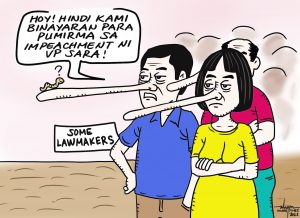BY KENT ALISTAIR GERONA
IN CLASSROOMS across the Philippines, students are memorizing outdated lessons while their teachers struggle to make ends meet. They are taught history that has been rewritten, skills that fail to equip them for modern careers, and values that serve political interests rather than critical thought. Meanwhile, the cost of education continues to rise, forcing many young Filipinos to abandon their studies in favor of employment.
As the education system deteriorates, politicians focus on the 2025 midterm elections—offering reforms that seldom materialize. The question is: Will voters finally demand accountability?
The implementation of the K-12 system was intended to enhance Filipinos’ competitiveness in the job market. However, in 2025, graduates still struggle to secure stable employment. Employers increasingly seek proficiency in artificial intelligence, digital literacy, financial management, and technical expertise, while schools remain anchored in an outdated curriculum.
A 2023 study by the Philippine Institute for Development Studies (PIDS) highlighted that the country’s curriculum is misaligned with industry needs, leaving many graduates underqualified for available jobs. The study also found that while K-12 was meant to make students “job-ready,” only a small percentage of graduates find employment without pursuing higher education. The result is a workforce that is ill-prepared, underpaid, or unemployed.
Election season routinely brings grand declarations about education reform, but what substantive changes have actually been made? Has the curriculum been modernized to align with industry demands? Has research and innovation received adequate investment? Or are the same budget allocations merely being repackaged under different slogans?
Beyond outdated curricula, another crisis looms: the continuous decline in teachers’ morale. Filipino teachers remain among the lowest-paid educators in Southeast Asia while being expected to manage overcrowded classrooms, outdated instructional materials, and an education system in decline.
A study published in The Philippine Journal of Education found that low salaries and poor working conditions significantly contribute to decreased motivation among teachers, directly affecting the quality of instruction students receive. The economic realities they face—coupled with an overwhelming workload—push many to seek opportunities abroad or leave the profession entirely.
So, without competitive salaries and improved working conditions, who will remain to educate the next generation?
However, the issue extends beyond teachers. Public education, once envisioned as a vehicle for upward mobility, has become increasingly inaccessible. Tuition hikes, hidden fees, and the soaring costs of basic school supplies place a heavy burden on families.
A report from the Philippine Statistics Authority (PSA) in 2024 revealed that economic hardship remains the leading cause of student dropouts, with over 20% of high school students leaving before graduation due to financial struggles.
Furthermore, the Commission on Higher Education (CHED) noted that tuition and other school fees increased by an average of 10% in private institutions over the past five years despite stagnant wage growth among Filipino families. Instead of focusing on their studies, many students are forced to prioritize financial survival. Politicians continue to champion free education policies while the dropout rate remains alarmingly high.
Perhaps the most insidious crisis in education today is the deliberate distortion of knowledge. Historical revisionism is not a distant threat—it is an active reality. Textbooks are sanitized, critical discussions are omitted, and misinformation spreads unchecked on social media. A generation is growing up with manipulated narratives, blind allegiance, and a limited understanding of the nation’s true struggles.
This is not a coincidence; it is a calculated strategy. An uninformed populace is easier to govern, easier to deceive, and easier to pacify with superficial campaign promises. The 2025 midterm elections are not merely about electing senators and local officials—they will determine the trajectory of Philippine education for years to come.
The coming elections are a test. Will voters demand comprehensive and actionable education reforms, or will they once again fall for rhetoric devoid of substance? As the 2028 presidential elections approach, will Filipinos finally demand leadership that prioritizes education not as a campaign strategy but as a national imperative beyond 2025?
This issue extends beyond students. It encompasses teachers, families, and the future of the nation. A country that neglects education does not merely fail its youth—it undermines its own future.
Will we choose leaders committed to real change? Or will we allow another generation to be left behind?
——————————————————-
Kent Alistair Gerona is a third-year political science student at the University of Cebu-Main Campus. This piece examines the challenges of the Philippine education system—including outdated curricula, increasing dropout rates, and the economic struggles of students and teachers. It also explores how political inaction has contributed to the sector’s decline.

